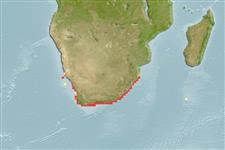Environment: milieu / climate zone / depth range / distribution range
Ecologie
marien; zoet water; brak water. Subtropical; 27°S - 35°S
Southeast Atlantic: restricted from Lüderitz, Namibia to northern Natal, South Africa.
Lengte bij maturiteit / Grootte / Gewicht / Leeftijd
Maturity: Lm 4.0 range ? - ? cm
Max length : 11.0 cm SL mannelijk / geslacht onbekend; (Ref. 7248)
Dorsale stekels (totaal): 6 - 9; Dorsale zachte stralen (totaal): 115; Anale stekels 1; Anale zachte stralen: 15 - 18. Body silvery and translucent with a midlateral band; dusky upper surface (Ref. 4125).
Forms schools along the coast and in estuaries, especially during spring (Ref. 3302). Also found in coastal lakes (Ref. 7248). Small individuals filter out small organisms such as phytoplankton and rotifers. Above 3.5 cm TL, it feeds mostly on crustaceans especially amphipods taken from the water column as well as off the bottom. Preyed upon by fishes and birds (Ref. 7248).
Levenscyclus en paargedrag
Maturiteit | Voortplanting | Paaien | Eieren | Fecunditeit | Larven
Skelton, P.H., 1993. A complete guide to the freshwater fishes of southern Africa. Southern Book Publishers. 388 p. (Ref. 7248)
Status op de Rode Lijst van het IUCN (Ref. 130435)
Gevaar voor de mens
Harmless
Gebruik door de mens
Visserij: visserij voor eigen gebruik; aas: usually
Meer informatie
ReferentiesAquacultuurAquacultuurprofielKweeklijnenGeneticaElectrophoresesErfelijkheidZiektesVerwerkingNutrientsMassaconversie
Tools
Speciale rapporten
Download XML
Internetbronnen
Estimates based on models
Preferred temperature (Ref.
123201): 14.3 - 23.9, mean 19.5 °C (based on 14 cells).
Fylogenetische diversiteitsindex (Ref.
82804): PD
50 = 0.5312 [Uniqueness, from 0.5 = low to 2.0 = high].
Bayesian length-weight: a=0.00776 (0.00426 - 0.01415), b=3.14 (2.97 - 3.31), in cm total length, based on LWR estimates for this species & (Sub)family-body (Ref.
93245).
Trofisch niveau (Ref.
69278): 3.4 ±0.46 se; based on food items.
Weerstandsvermogen (Ref.
120179): Gemiddeld, minimale populatieverdubbelingstijd 1,4-4,4 jaar (Preliminary K or Fecundity.).
Fishing Vulnerability (Ref.
59153): Low vulnerability (10 of 100).
